


|
4 May 2010 INTRODUCTION I'm no fan of 3-D movies, as you no doubt know by now, and am plugging away at a lengthy essay on why I don't think 3-D has ever worked in the long history of the movies. That's not finished yet so here's a related discussion based on something that came up over the weekend. I was trying to explain why 3-D movies confuse the brain and can cause headaches, dizziness, and nausea but, despite waving a Sharpie around like a lunatic, I don't think I was very eloquent in my explanation. Here is another go at explaining it using some illustrations I whipped up over breakfast. And for the record, this has nothing to do with my dislike of the format. This is a neutral explanation of how it works and the sciencey reason of why the brain sometimes falters. YOU HAVE A CUBE So okay, imagine that you have a very lovely Primary Color Cube sitting in front of you. It's an actual, real cube sitting on your desk and occupying three-dimensional space. You can freely move around the cube, manipulate the cube, and observe the cube using as many of your senses as you wish to apply to the task. This is what the Primary Color Cube looks like. It has a yellow top. You line up the cube so that a corner is pointing toward you. The left side from your perspective is blue while the right is red.  Now crouch down and view the cube head-on, looking straight down both sides of that corner. 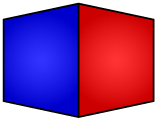 Move your head slightly to the left of center. Then move slightly to the right of center. 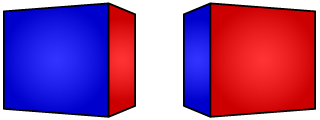 Now stand back up and do that again, first to the left and then to the right. 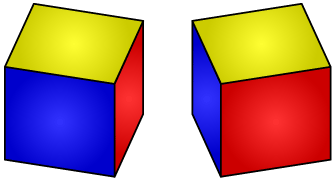 Good! You are now acquainted with your Primary Color Cube. Let's move on. AT THE MOVIES After a long day of ogling your Primary Color Cube you decide to go out and relax at a movie. Interestingly enough, it's about an identical Primary Color Cube (as all Primary Color Cubes are indeed identical). It is also being shown in 3-D! You pay an extra five bucks for the experience. Now, if this were a standard 2-D format movie you would see three-dimensional space being presented entirely on a flat plane. You're a clever person and you understand that 2-D movies represent depth of field and perspectives just fine. Here is a representation of the 2-D version of the movie you're about to see: 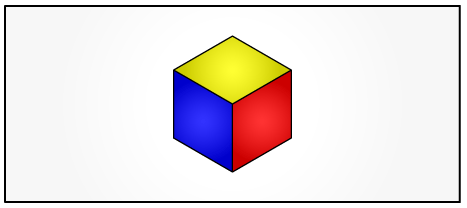 But of course everyone's been raving about the 3-D version. That Primary Color Cube really pops out at you. Amazing! 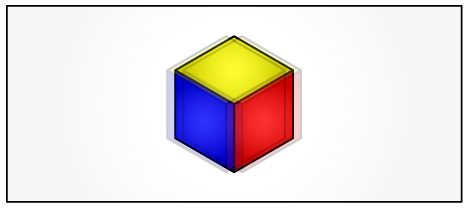 You might wonder, "This is all fine and dandy, but how does it work?" It's tricky but, to make things as easy as possible, here is a simplified explanation. With the RealD system, which is the most common 3-D movie system in theaters right now, the projector is beaming the film through a polarized filter and onto the screen. If you take your special viewing glasses off you'll notice that the picture is fuzzy. In fact, it's a set of closely-grouped double images. The film is effectively on the screen twice. That's where your stylish glasses come in. The oppositely polarized lenses are designed to only pick up one set of images on the screen apiece. This is accomplished by the two images on the screen having a left image and a right image. The left image is projected with a counter-clockwise polarization and the right image has a clockwise polarization. This honestly doesn't mean anything but a lot of technical gibberish but, by giving each image a different polarization, each lens of the glasses can pick up only their own respective image due to the opposite polarization of the material. In other words, the left lens only allows in the designated left image and the right lens only allows in the designated right image. A polarized image rotating opposite what the lens allows for is completely blocked out. If that's not confusing enough, the images are blinking on and off. Neither image is on screen at the same time. When the left image is on, the right image is off. When the right image is on, the left image is off. The images toggle on and off at such a high rate -- 144 times per second -- that the human eye cannot pick up the toggling. In addition to all that, the image is being projected three times in an attempt to reduce flickering between frames. So it's a complicated system. 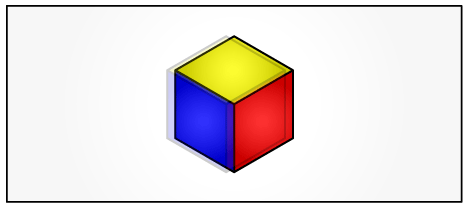 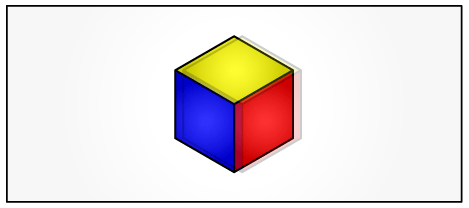 That's how things work on the theater's end. But what about on your side? INSIDE YOUR HEAD Your eyes work by bringing in two separate images (assuming normally working eyes) that are combined by the brain into one single image (assuming a normally working brain). Each image, the left and the right, lack depth on their own. It's the combination of these two images, each one slightly offset from the center line, that allows a three-dimensional image to be formed by the brain. Remember your trusty Primary Color Cube?  Standing at that centered perspective, each eye takes in a slightly different off-center view of the cube. The brain processes these two images and churns out a lovely three-dimensional image.  That's how things worked at home. The problem is that now you're at the movies and wearing those 3-D glasses. The Primary Color Cube that you're staring at, while it looks three-dimensional (and indeed it would appear to have depth whether you're watching a 2-D or a 3-D movie, that doesn't matter), is only being beamed onto a flat surface. In other words, no matter how you move around the theater, no matter how close you get to the screen or how far to the sides you move, that image of the cube will never change perspective. 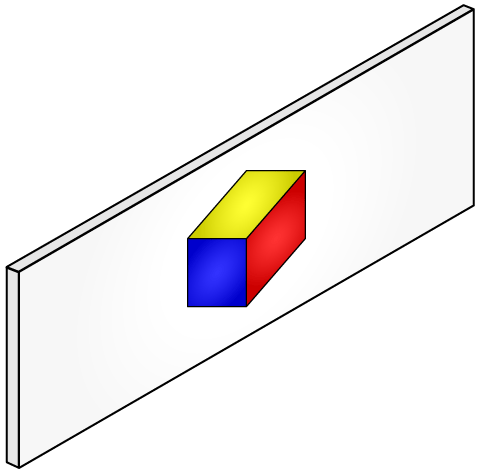 With a 2-D movie your brain has an easier time working out this dilemma. It's essentially the same as looking at a painting or a photograph. Despite the image appearing to have depth, everything in it exists on a single plane. The filmmaker, artist, or photographer can make the background slightly out of focus in order to concentrate on foreground image, and your brain can perceive probable distances from what's visible. In any case, both eyes are being used to take in the same image, from the same focal point. Left eye and right eye are seeing the same thing at the same time. This changes when you introduce the 3-D polarization process. Recall that there are two images flashing on and off 144 times a second and that these two images are slightly offset and calibrated to be received by a specific eye. Suddenly both eyes are not seeing the same thing at the same time and they are not using the same focal point. Instead, both eyes are operating independently but seeing the exact same image. Because the 3-D movie is being projected onto a flat screen, the on-screen imagery is still flat. That Primary Color Cube on the big screen only has one perspective being shown and, again, no matter where you move in the theater, that perspective does not change. What this means is that each eye receives the same view, independent of one another, and since these two views are themselves offset (due to the two images being projected that way and then sorted out by the opposite polarization glasses), the brain receives something that it's not used to receiving. The brain receives two identical images from eyes that are not directed upon the same focal point. Furthermore, because the images onscreen are toggling on and off, neither eye is receiving the same information at the same time, even if the toggling is imperceptible to the brain. 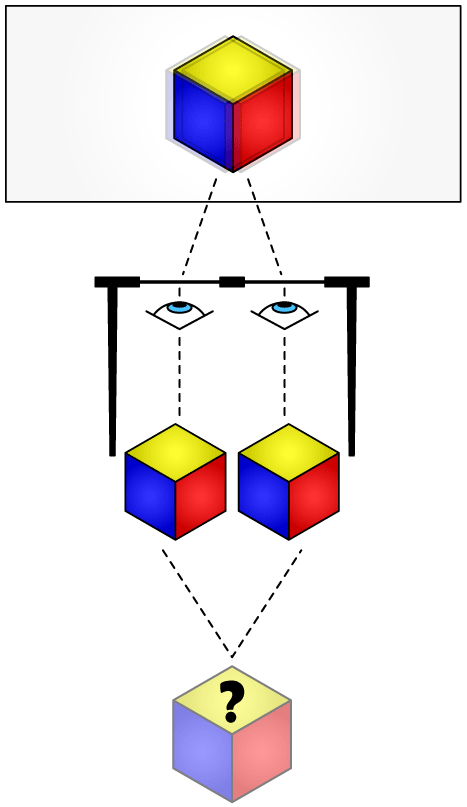 Because of this conflicting information, the brain is prone to stumbling over the sensory input, leading to the aforementioned possible headaches, dizziness, and nausea. The viewer, of course, experiences three-dimensionality from the imagery on screen because it doesn't completely fry the brain. It's just enough confusion to throw the brain off. Moreover, an additional effect that 3-D films can have is a false sense of motion. Try closing your eyes and moving your head erratically. Or spinning around. You maintain your balance by the movement of fluids inside your inner ear. These fluids slosh around as you move naturally. But cut off visual signs of movement (i.e., by closing your eyes) or cut off physical signs of movement (i.e., watching a 3-D movie), and the inner ear fluids do not move according to how the brain expects them to. By spinning around the fluids move normally but closing your eyes removes any signs of movement. The brain gets confused. By watching a 3-D movie the fluids do not move but your eyes register signs of movement. The brain gets confused. CONCLUSION Hopefully this doesn't come off as too negative towards 3-D movies. I was really trying to be as unbiased as possible this time around. Next time I'll be more scathing but here all I wanted to do was present the science of mental upset that these films can cause. Of course, it's nothing inherently dangerous unless you are prone to epileptic seizures or similar disorders but, frankly, 2-D movies can do that just as well. Just ask anyone hospitalized over a Pokémon cartoon. I'll personally stick to 2-D movies but now you know what's going on inside your head. Now run along and play with your Primary Color Cube. DISCLAIMER For what it's worth, I've never really had any problems with the 3-D movies I've gone to see. Not everyone is affected by them in the same ways. I simply prefer to see films in the 2-D format. EDITS May 5 : Redrew angled isometric cubes. May 6 : Redrew forward projections of cube.  Articles Articles
|
 |